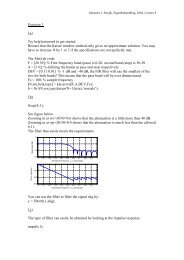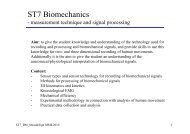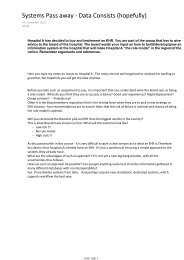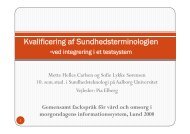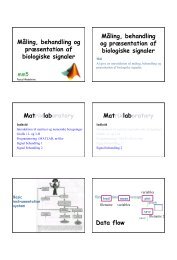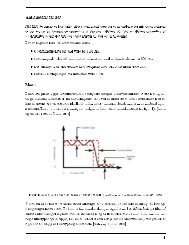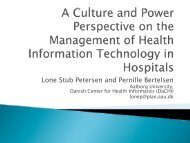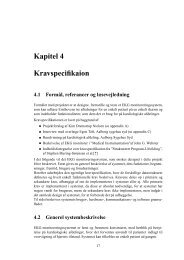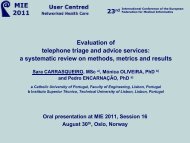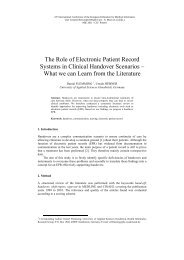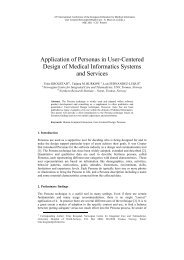presentation
presentation
presentation
You also want an ePaper? Increase the reach of your titles
YUMPU automatically turns print PDFs into web optimized ePapers that Google loves.
Anne Randorff Højen,<br />
SHI Linköping,<br />
Oktober 2012<br />
Applying visualization to support coherent<br />
terminology implementation
Motivation for terminology implementation<br />
TERMINOLOGY<br />
2<br />
Effects<br />
Sharing<br />
Retrieval<br />
Aggregation
Navigation, concept selection, overview !<br />
3
Why common terminology is not enough?<br />
… Analyzing SNOMED CT<br />
Example:<br />
Physical examination template<br />
Ear:<br />
Nose:<br />
Throat:<br />
… …<br />
… …<br />
… …<br />
Observable<br />
entity<br />
Ear, nose /<br />
throat<br />
observable<br />
Ear<br />
observable<br />
SNOMED CT<br />
Concept<br />
Cinical<br />
finding<br />
Finding of<br />
face<br />
Finding of<br />
nose<br />
Body<br />
structure<br />
Neck<br />
structure<br />
Throat<br />
4
Why common terminology is not enough?<br />
… Analyzing SNOMED CT<br />
Example:<br />
Physical examination template<br />
Ear:<br />
Nose:<br />
Throat:<br />
… …<br />
… …<br />
… …<br />
Throat<br />
finding<br />
SNOMED CT<br />
Concept<br />
Clinical<br />
finding<br />
Finding of head<br />
and neck region<br />
Nose<br />
finding<br />
Ear finding<br />
5
Finding of<br />
nose<br />
SNOMED CT<br />
Concept<br />
Clinical<br />
finding<br />
Finding of head<br />
and neck region<br />
Ear finding<br />
Least common parent<br />
Throat<br />
finding<br />
Observable<br />
entity<br />
Ear, nose /<br />
throat<br />
observable<br />
Ear<br />
observable<br />
SNOMED CT<br />
Concept<br />
Cinical<br />
finding<br />
Finding of<br />
face<br />
Finding of<br />
nose<br />
Body<br />
structure<br />
Neck<br />
structure<br />
Throat<br />
6
Balancing specificity and comparability<br />
7
How to support comparability?<br />
8
How to support comparability?<br />
1. Mapping guidelines<br />
• Common strategy for navigating the SNOMED CT<br />
hierarchies and selecting sufficient concepts.*<br />
2. Terminology vizualisation tool<br />
• Overview of ‘local’ terminology with respect to the structure<br />
and content of SNOMED CT.<br />
*[”SNOMED CT implementation: Mapping Guidelines facilitating reuse of data”,<br />
A. Rasmussen, K. Rosenbeck Gøeg, Methods Inf Med 2012, 51.]<br />
9
Work proces<br />
Research group<br />
(SNOMED CT experts)<br />
Medical staff / EHR end users<br />
EHR – implementation team<br />
10
finding relating to<br />
psychosocial<br />
functioning<br />
11<br />
Manuel visualisations<br />
Example: Nusing status<br />
nutritional<br />
finding<br />
Psychological<br />
finding<br />
Mental state, behavior<br />
and/or psychosocial<br />
function finding<br />
Endocrine,<br />
nutritional and<br />
metabolic<br />
finding<br />
Clinical history and<br />
observation findings<br />
Reproductive<br />
finding<br />
Cognitive<br />
function finding<br />
finding relating<br />
to sexuality and<br />
sexual activity<br />
Functional<br />
finding<br />
finding of<br />
functional<br />
performance and<br />
activity<br />
Communication,<br />
speech and<br />
language finding<br />
Finding<br />
related to<br />
sleep<br />
sleep rest<br />
pattern finding<br />
SNOMED CT<br />
Concept<br />
Clinical<br />
finding<br />
General<br />
finding of<br />
observation<br />
of patient<br />
Elimination<br />
pattern<br />
Mucosal<br />
Finding<br />
Social<br />
context<br />
finding<br />
Value belief<br />
finding<br />
Neurological<br />
finding<br />
Sensory nervous<br />
system finding<br />
Finding by<br />
site<br />
Integumentary<br />
system finding<br />
Pain / sensation<br />
finding<br />
Pain<br />
Skin<br />
Finding<br />
Finding<br />
of body<br />
region<br />
Observation of<br />
sensation<br />
Cardiovascular<br />
finding<br />
Respiratory<br />
finding<br />
finding of<br />
respiration
12<br />
Manuel visualisations<br />
Example: Nusing status<br />
Common Parents<br />
template- concept<br />
Model-concept<br />
fund vedr.<br />
religiøst<br />
tilhørsforhold<br />
fund vedr.<br />
personlig status<br />
fund vedr.<br />
ægteskabelig- eller<br />
partnerskabsstatus<br />
Fund ved anamnese vedr.<br />
sociale og personlige forhold<br />
Environmental<br />
finding<br />
Housing, local<br />
environment and<br />
transport finding<br />
Fund vedr.<br />
bopæls- og<br />
boligforhold<br />
SNOMED CT<br />
Concept<br />
Clinical finding<br />
Finding by<br />
method<br />
History finding<br />
Fund vedr.<br />
beskæftigelsesstatus<br />
Legal, financial,<br />
employment and/or<br />
socioeconomic<br />
history finding<br />
Employment<br />
finding<br />
Functional<br />
finding<br />
fund vedr.<br />
almindelig daglig<br />
livsførelse<br />
beskæftigelse<br />
shistorie<br />
Clinical history and<br />
observation findings<br />
Communication,<br />
speech and language<br />
finding<br />
Fund vedr. tale<br />
og sprog<br />
Fund vedr. husstand,<br />
familie og netværk<br />
Family details and household<br />
composition - finding<br />
Fund vedr.<br />
familiemæssige detaljer<br />
Administrative<br />
statuses<br />
Patient encounter<br />
status<br />
Need for<br />
interpreter<br />
tolk påkrævet
Method<br />
Physical anatomical<br />
entity<br />
Body tissue structure<br />
Soft tissues<br />
SNOMED CT<br />
Concept<br />
Body structure<br />
Anatomical structure<br />
Structure of<br />
cardiovascular<br />
system<br />
Blood vessel<br />
structure<br />
Anatomical or<br />
acquired body<br />
structure<br />
Body system<br />
structure<br />
Body organ structure<br />
13
Method<br />
Physical anatomical<br />
entity<br />
Body region structure<br />
Body part structure<br />
Regional<br />
cardiovascular<br />
structure structure<br />
SNOMED CT<br />
Concept<br />
Body structure<br />
Anatomical structure<br />
Cardiovascular<br />
structure of trunk<br />
Anatomical or<br />
acquired body<br />
structure<br />
Body system<br />
structure<br />
Structure of<br />
cardiovascular<br />
system<br />
Trunk structure<br />
Physical anatomical<br />
entity<br />
Body tissue structure<br />
Soft tissues<br />
SNOMED CT<br />
Concept<br />
Body structure<br />
Anatomical structure<br />
Structure of<br />
cardiovascular<br />
system<br />
Blood vessel<br />
structure<br />
Anatomical or<br />
acquired body<br />
structure<br />
Body system<br />
structure<br />
Body organ structure<br />
14
Method<br />
Physical anatomical<br />
entity<br />
Body region structure<br />
Body part structure<br />
Regional<br />
cardiovascular<br />
structure structure<br />
SNOMED CT<br />
Concept<br />
Body structure<br />
Anatomical structure<br />
Cardiovascular<br />
structure of trunk<br />
Anatomical or<br />
acquired body<br />
structure<br />
Body system<br />
structure<br />
Structure of<br />
cardiovascular<br />
system<br />
Trunk structure<br />
Physical anatomical<br />
entity<br />
Body tissue structure<br />
Soft tissues<br />
SNOMED CT<br />
Concept<br />
Body structure<br />
Anatomical structure<br />
Structure of<br />
cardiovascular<br />
system<br />
Blood vessel<br />
structure<br />
Anatomical or<br />
acquired body<br />
structure<br />
Body system<br />
structure<br />
Body organ structure<br />
15
Method<br />
Physical anatomical<br />
entity<br />
Regional<br />
cardiovascular<br />
structure<br />
Cardiovascular<br />
structure of trunk<br />
SNOMED CT<br />
Concept<br />
Body structure<br />
Anatomical structure<br />
Body system<br />
structure<br />
Structure of<br />
cardiovascular<br />
system<br />
Anatomical or<br />
acquired body<br />
structure<br />
Blood vessel<br />
structure<br />
16
Potential of visualization<br />
• Overview of concepts and their relations<br />
• Compare single concepts<br />
• Compare groups of concepts<br />
17
Potential of visualization<br />
• Overview of concepts and their relations<br />
• Nutritional finding<br />
• Reproductive finding<br />
• Finding relating to sexuality and<br />
sexual activity<br />
• Communication, speech and<br />
language finding<br />
• Finding relating to psychosocial<br />
functioning<br />
• Cognitive function finding<br />
• Sleep rest pattern finding<br />
• Elimination pattern<br />
• Value belief finding<br />
• Pain<br />
• Observation of sensation<br />
• Finding of functional<br />
performance and activity<br />
• Mucosal Finding<br />
• Skin Finding<br />
• Finding of respiration<br />
• Cardiovascular finding<br />
18
Potential of visualization<br />
• Compare single concepts<br />
Pain<br />
Neurological<br />
finding<br />
Sensory nervous<br />
system finding<br />
Pain / sensation<br />
finding<br />
Observation of<br />
sensation<br />
19
Potential of visualization<br />
• Compare groups of concepts<br />
20
Potential of visualization<br />
Template A Template B<br />
finding of sense<br />
of taste<br />
finding of sense of<br />
smell<br />
Mucosal<br />
Finding<br />
Pain<br />
Neurological<br />
finding<br />
Sensory nervous<br />
system finding<br />
Pain / sensation<br />
finding<br />
Observation of<br />
sensation<br />
SNOMED CT<br />
Concept<br />
Clinical<br />
finding<br />
Finding by<br />
site<br />
Integumentary<br />
system finding<br />
Skin<br />
Finding<br />
Finding<br />
of body<br />
region<br />
Cardiovascular<br />
finding<br />
Finding of<br />
respiration<br />
Respiratory<br />
finding<br />
Asthma<br />
finding<br />
Blood vessel<br />
finding<br />
Cardiac<br />
finding<br />
Chronic obstructive<br />
pulmonary disease<br />
finding<br />
21
Potential of visualisation<br />
• Support collaboration within the EHR-implementation<br />
process<br />
• Starting point for discussions/-collaboration on EHR-content<br />
• Common reference and overview of all content for all actors<br />
Making content transparent!<br />
22
Future work<br />
• Development and evaluation of:<br />
• Automatic visualization<br />
• Dynamic tool<br />
23
… for your attention!<br />
24



